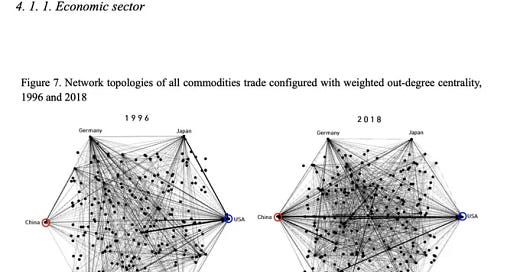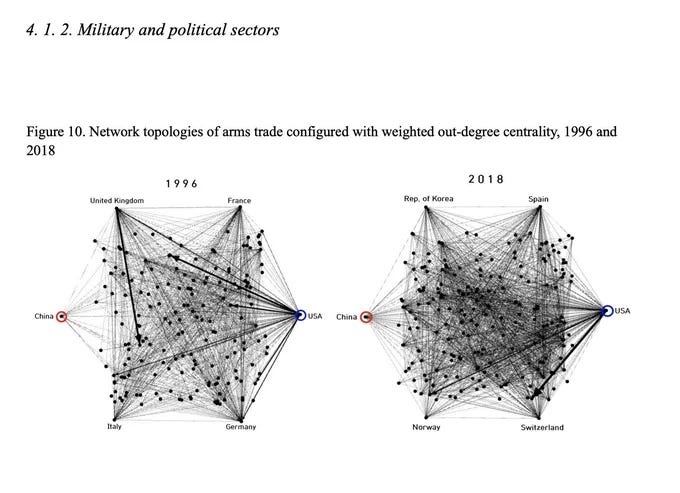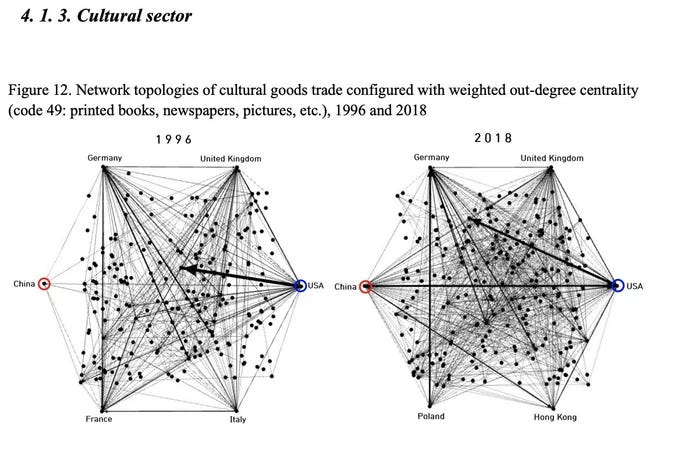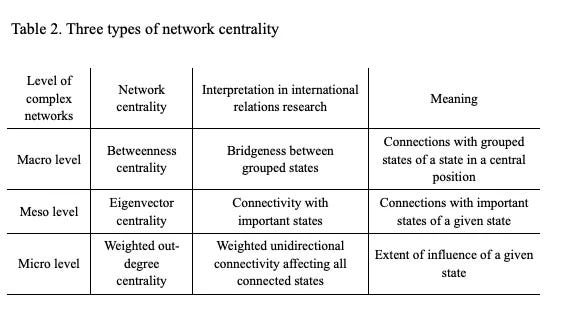Will the United States maintain its spot as the world’s dominant superpower during the 21st century, or will it be displaced by China? Perhaps we are slowly entering a multi-polar world order filled with several competing powers and no clear leader?
This is an important question for everyone on the planet to consider, not just academics and policy makers. Rapid technological advancements in areas such as AI, robotics, and biotechnology will give the superpowers of the 21st century unprecedented capabilities to directly influence events across the globe.
The shape of the emerging world order will impact human rights, civil liberties, and economic development for all of us.
This piece will explore how network science can help us explore geopolitical dynamics in a way that gives us much more nuance and detail than we get using traditional approaches in the social sciences. Our greater understanding will improve our ability to anticipate how events may unfold and identify ideal leverage points for influencing future outcomes.
Hegemony
Renowned American political scientist John Mearshimer defined hegemony as “domination of the entire world.” Over the past several centuries, the title of world hegemon has been transferred from the Dutch, to the United Kingdom, and most recently to the current American global empire.
The chart below indicates that we may be on the cusp of another transition. One of the world’s oldest empires, China, is on a clear path to reclaim its position on the top.
How can we assess the progress of this hegemonic transition? First, let’s take a look at the standard approach before exploring the benefits offered by using network science.
The Reductionist Approach
Most academic discussions about the battle for hegemony between the U.S. and China focus on measuring total economic output. Gross Domestic Product (GDP) is used as a proxy for economic power and total power. Because the amount of goods and services being created in China is increasing, they are becoming more powerful.
The problem with this approach is that GDP doesn’t tell us very much about power. GDP simply measures the market value of all goods and services produced in a state. High GDP is correlated with greater potential to project and wield power, but it doesn’t measure power directly.
A state’s power should be measured by the amount of influence it exerts on other states within the structure of international relations. Because GDP tells us nothing about the interactions between states, we need a new approach. Network science provides the tools we need to study the relationships in the complex geopolitical system.
A Networked Approach
The authors of a 2020 paper Network Analysis of the US–China Hegemonic Transition use a novel approach to study the issue of hegemonic transition. They demonstrate how network science allows us to use relational concepts in order to measure structures and systems. Their approach is grounded in a definition of hegemony as “the social, economic, and cultural predominance of one state or organization and the resulting influence on others.”
A summary of the key concepts and methods that the authors used will help us understand the power of network science to demystify complex systems.
Network Creation
The data used for analysis came from the United Nations International Trade Statistics Database. Trade data between 243 countries from the years 1996-2018 was collected. Three different categories of data were chosen to measure the different forms of influence that states have; economic, political/military, and cultural.
I’m going to provide a brief overview of each category of data below. I’ll be drawing from current events in the war between Russia and Ukraine to help demonstrate their relevance before moving on to the main analysis of the relationship between the U.S. and China.
Economic Influence
Data on the trade of all commodities between states was used to assess economic influence.
The graphs below show 243 nodes, each representing a country. The countries are connected by a total of 20,092 links through mutual trade. The network on the left shows the state of trade between countries in 1996, the network on the right represent the state of affairs in 2018.
When a state exports a commodity such as oil, natural gas, steel, or grain it exerts influence on the importing country by increasing the importer’s dependence on the exporter. States depend on commodities to power their infrastructure and society.
Much of the world is heavily dependent on Russian grain exports which has led to concerns about global food security in the event that Russia chooses to withhold grain as a negotiating tactic. These fears materialized yesterday when Russia officially pulled out of a major grain deal, immediately sending the global prices of wheat, corn, and soybean skyrocketing.
Political and Military Influence
Data on the trade of weapons was used to assess political and military influence.
When a state sends bombs, missiles, and ammunition to other states it improves the military capabilities of the receiver and strengthens the political friendship between the buyer and seller. Once again the importing country starts to become dependent on the exporter.
Ukraine’s capacity to wage war is entirely dependent on the constant flow of arms from the West. Western military support has created political goodwill which opened the door for U.S. corporations like Blackrock and JP Morgan to invest in and profit from future efforts to rebuild Ukrainian infrastructure.
Cultural Influence
Finally, data on the trade of media such as books, newspapers, and photographs was used to assess cultural influence.
States use media as a way of exerting “soft power” on other states. Media can have a strong influence on the beliefs, desires and behavior of those who consume it. Soft power allows exporters of culture to achieve desired outcomes through attraction rather than coercion.
Any honest observer and student of history can see that Russia, Ukraine, the United States, and China are all pumping out propaganda about the war through official channels and state affiliated news outlets. The media they produce is designed to sway hearts and minds in a way that helps the propagandists achieve their goals.
Network Analysis
Now that we have our graphs, what exactly can we learn from them?
Our analysis focuses on network centrality as the key measure that allows us to identify important states in international relations and determine the possibility of a hegemonic transition between superpowers.
Network centrality measures how central, or important a node is within a network. A high level of centrality is associated with a high position within a status hierarchy and significant control over valued resources.
Three types of centrality are used to assess power dynamics.
Betweenness centrality at the global/community or “macro” level.
Eigenvector centrality at the group or “meso” level.
Weighted out-degree centrality at the individual “micro” level.
Let’s take a look at each of these centrality measures within the economic domain.
Betweenness Centrality
Betweenness centrality measures the extent to which a node falls between other nodes in a network. It helps us understand the overall importance and influence of a node within a network structure.
In the figure below, the nodes in groups 1 and 2 must pass through node A in order to interact with each other. Node A serves as a bridge between the two groups and it has the highest centrality score of all the nodes.
Betweenness centrality can help us measure the extent to which a state serves as a central economic and political bridge between groups of states. Looking at the degree to which a global superpower plays a central role in bridging gaps between clustered groups of countries can help us evaluate who has hegemony.
While the gap between the U.S. and China has been closing in recent years, the U.S. still plays a dominant bridging role in the economic domain and has not yet been surpassed by China.
Eigenvector Centrality
Eigenvector centrality measures how many important nodes a given node is connected to at the meso level. When a node is connected to many important nodes, it becomes more important itself and can exert more influence.
In the figure below, A is connected to several important nodes and has a higher eigenvector centrality score than the other nodes which lack these connections.
Eigenvector centrality helps us assess whether a state has ties with other important states in international relations. The more important states it is connected to, the more influence it has on the global stage.
The United States and China are both members of the intergovernmental group of seven (“G7”) countries that includes other world powers like the U.K. and Germany. Their intimate connections with other influential states increase their ability to impact the structure of the global world order.
China was linked to more important states from 2014 -2017 but the U.S. reclaimed its spot on top in 2018.
Weighted Out-Degree Centrality
Weighted out-degree centrality measures how much one node influences another node in a specific direction at the micro level.
In the figure below, Node A is exerting influence on two nodes on the right. The thickness of the line indicates the “weight” of the link, or the amount of influence. In a trade network between states the weight would indicate the amount exported by a given state.
This measure helps us assess how much influence a state exerts on other individual states. States with high out-degree centrality are heavy exporters.
China has been consistently dominating in this arena since 2007. China’s massive economy has a greater capacity to exert influence on individual states, such as those in Africa, through its exports. But this does not translate directly into a capacity to influence the overall structure of the international order in the same way that the U.S. can.
Conclusions
Based on the analysis covered in the section above, the authors conclude that while China has achieved hegemony at the micro level in the economic sector, they are competing with, but haven't yet surpassed the U.S. at the meso and macro levels. China has a greater quantity of influence over individual states, but the US leads in terms of the quality of important relationships within the overall network structure.
Similar analyses in the other two sectors show that China is barely competing militarily, and has growing but still relatively weak cultural influence. Despite very real signs of competition from China, the U.S. maintains hegemony in international relations.
Application and Open Questions
Application
Network science can be used to achieve a holistic understanding of the geopolitical relationship between the U.S. and China and the battle for global hegemony. Unlike traditional indicators like GDP, network centrality measures allow us to directly measure and assess the relationships which are are at the heart of geopolitical power.
Policy makers and military leaders could use this type of analysis to help answer important questions. For example, if the U.S. were to gradually retreat from its role as the world’s police force, in which countries would it be most essential to leave a significant military presence?
If the U.S. were to place a greater emphasis on exerting economic influence and soft power, what central nodes should it focus on in order to make changes that would effectively propagate throughout the global network?
Open Questions
As exciting as this research is for me, it also raises plenty of questions.
Could we use the methods outlined in this paper to create an interactive dashboard with richer network visualizations that make the data more widely accessible?
How has the situation changed since this paper was published in 2020? Between Covid and the Russo-Ukrainian war, the world is a very different place.
What are the limitations of this data set and how could it be augmented with additional sources? For example what sort of data would allow us to rigorously assess the important role played by social media platforms like Twitter in helping countries influence culture?
Network science is one of my favorite sub-disciplines within systems science, and I believe further research on this specific topic would be very valuable. If you’re a network scientist or programmer with any interest in exploring this subject, please reach out!
















